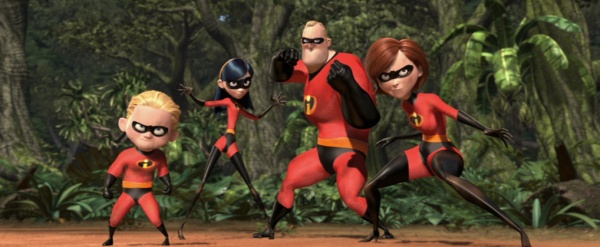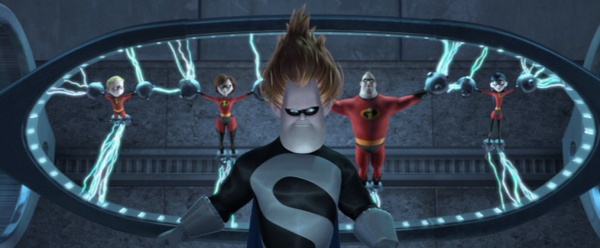The Incredibles (Brad Bird, 2004)
Brad Bird’s The Incredibles is the latest in the extraordinary winning streak of the Pixar animation studio, but it is also a film that challenges everything we thought we knew about Pixar films. In their first five features (Toy Story, A Bug’s Life, Toy Story 2, Monsters Inc, and Finding Nemo) a house style emerged based largely on the sensibilities of John Lasseter, director or co-director of three of those five films, and generally we know what to expect from the studio. Their features are unashamedly kids’ films, albeit ones rich enough to entertain all ages. They use non-human characters (toys, insects, monsters, fish) for their central cast. They centre on a pair of “buddy” heroes (Woody and Buzz, Sulley and Mike, Marlin and Dory), or a troupe of friends who all work together. The tone – warm, gently sentimental, and without cynicism – strongly recalls the best of the early Disney animated films. This consistency in approach surely derives from the use of in-house directorial talent, with the directors other than Lasseter (Lee Unkrich, Pete Doctor and Andrew Stanton) having learnt the ropes working alongside Lasseter.
The Incredibles sweeps aside these assumptions. Only incidental aspects (the use of some child characters, an absence of intense or graphic violence, and the fact that its animated) mark it as a kid’s film: basically, this is a superhero action movie for a general audience, not very different in approach from Sam Raimi’s Spiderman. The central conceit – that a family of superheroes have to hide their identities to avoid litigation – is not pitched at kids, and the issues that arise from it (such as the sense of entrapment arising from Mr Incredible’s domestic obligations and soul-destroying job) are designed to resonate with adults. The use of an all-human cast is a first, as is the use of a family as the central group. Not coincidentally, the change in tone and approach comes with the first use of an established outside talent to helm a Pixar production: writer-director Brad Bird came to Pixar after producing the widely acclaimed (but little seen) The Iron Giant for Warner Bros in 1999.
Bird’s film may not be better than the best of the earlier Pixar films (I think Nemo and the two Toy Story films are the strongest), but it’s nevertheless a huge leap forward for Pixar. I say that because, by being so different from its predecessors, it takes the studio out of its comfort zone. In my review of Finding Nemo, I made the comparison between Pixar’s first five films and Disney’s first five, which count as one of the all-time great creative streaks in Hollywood history. (Just to save you clicking across, between 1937 and 1942 Disney released Snow White, Pinocchio, Fantasia, Dumbo, and Bambi). Those films defined a medium and set a standard that’s never been matched, at least not with any consistency. Yet for all that, they were essentially the same type of film: even Fantasia, the clear odd one out, didn’t decisively break Disney in a new direction, being essentially a collection of particularly well-executed shorts. The Disney house style was so strong that in the decades since, the Disney studio films took many, many years to escape the territory Walt mapped out in those first five features (and did so uncertainly when they did). By contrast, with The Incredibles Pixar have shown that they can accommodate a different sensibility, a different point of view, and a different approach to storytelling than the reassuring kids’ films they defined themselves with. There are no syrupy Randy Newman ballads here.
Instead, Birds’ film throws itself headlong into its action / superhero genre material. He makes full use of computer animation’s ability to furnish really big sets and really large scale action sequences. The production design – if that’s the term in animation – is beautiful, suggesting Ken Adam’s work for the 60s Bond films. Yet where Adam’s sets were always constrained by the realities of construction, the freedom of computer animation allows for sets that are airier and less confined. The expansiveness is often required, since many locations are the setting for epic battles, as the Incredible family fights giant killer robots and other supervillain menaces. In these portions of the film, the character animation tradition that Pixar is known for intersects with a different tradition of computer animation: the use of computers in blockbuster special effects pictures such as Attack of the Clones or Return of the King to animate monsters, villains, crowds, armies, or scenes of general mayhem and destruction. I’ve seen some jaded critics complain about Bird’s use of such sequences, as if they’re a vulgar gesture towards the infantile tastes of modern audiences. On the contrary, I have no problem with a rousing action climax, and think these sequences grow naturally out of the material that Bird is working with – my problem with the rash of such scenes in other movies is that they’re usually done badly, or within otherwise bad films. Bird, however, is good at this kind of thing, and the closing scenes will have a ring of familiarity about them for those who saw his The Iron Giant. As with that earlier film, he manages to smoothly change gears and build the film to an exciting conclusion that grows naturally out of what came before, without jettisoning character along the way. Just as importantly, he stages his action well, without the hyperkinetic cutting or claustrophobic framing that most live-action directors use to try to hype up their action scenes. He’s also good at little comic bits, with a funny sequence involving Elastigirl and a series of doors reminding me of the throwaway sequence in The Iron Giant where the giant’s hand wanders into Hogarth’s house.
If spectacle was all that The Incredibles delivered, though, I would probably be as lukewarm on it as I was about Shrek 2, complaining that it was failing to fulfil the potential of the medium. (Never a fair complaint, but an inevitable one due to the way animation fans like myself are constantly looking for a renaissance of the art form). But Bird is one of the leading stewards of animation working today, up there with John Lasseter and Nick Park, and The Incredibles is also exciting as a leap forward in computerised character animation. Bird’s background in traditional cartoons has informed the character design and animation, with the array of human characters designed in a stylised manner that doesn’t make any attempt at photorealism. This means that the character design avoids the awful doll-like stiffness seen in the humans in Shrek 2, and is far from the creepy zombie-like characters that so famously sank The Polar Express. The animation itself is loose and expressive, building on strong vocal performances by Craig T. Nelson (as Mr Incredible), Holly Hunter (Elastigirl), and Jason Lee (the villainous geek Syndrome). Bird himself contributes a funny supporting vocal role as Edna Mode, costume designer to the superheroes, and the animation on Mode is a perfect example of the sensibility Bird brings to the film. In Shrek 2, someone had gone to a lot of trouble to make the human characters move realistically, but here, the effort has instead gone into making them move in a way that supports a comic performance. Mode has the big-headed, little-bodied appearance of a Warner Bros cartoon character, and her walk is reminiscent of the comic movements that Chuck Jones, Robert Clampett, and Friz Freleng would use in those cartoons (think, perhaps, of Clampett’s version of Tweety). There is nothing that indicates more assurance with character animation than the ability to move beyond it into comic performance.
Bird is sufficiently comfortable with his hold on character animation that he is willing to let the first half of the movie be almost entirely character driven. He takes his time doing so, ignoring the conventional wisdom that animated films should not push their luck far beyond 90 minutes, instead using a full two hours to tell the tale of the disaffected Mr Incredible and his family. The film does lag a little in its mid-portion: perhaps some tinkering with the story could have got him to the same place faster. But it’s quibbling to harp on such a point, when the extra time is spent on strengthening his characters. (Bird gets it from both directions, I’ve noticed: he gets criticised for building his movie too slowly, but then also cops it for providing cheap, easy gratification with his big action sequences in the second half of the movie). A more legitimate criticism is that the film’s “message” doesn’t make a great deal of sense. Bird likens the repression of the Incredibles’ abilities to society’s tendency to scorn the gifted and elevate the mediocre: when everybody is special, no-one is, complains Mr Incredible’s son Dash. There’s the start of a good idea there, but as Michael Barrier and others have pointed out, Bird doesn’t really pull it together properly. It’s just silly at the end of the movie when Dash, who has superpowers, is competing in junior athletics against kids with regular abilities. Is that the message of the movie: that natural ability matters more than dedication or effort? The villain, Syndrome, is proud of the fact that he has achieved everything he has without having such superpowers, and you know what? He’s right. It is impressive that despite him being born without powers it still takes six superheroes working in concert to thwart his evil plan. There’s something awry when you get to the moral of the movie and it’s the villain who is making sense.
Perhaps it’s picky to point out such a flaw. Maybe the movie shouldn’t have worried about having such an overt message: it’s fashionable to be cynical about morals in kid’s films. Yet one of the things I most liked about Finding Nemo was that it did manage to incorporate an important and positive message about living life to the fullest and not fearing the unfamiliar. That The Incredibles can’t quite marry its plot and its subtext in the same way is a shame, because it’s pretty much flawless otherwise.

